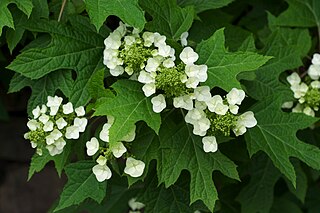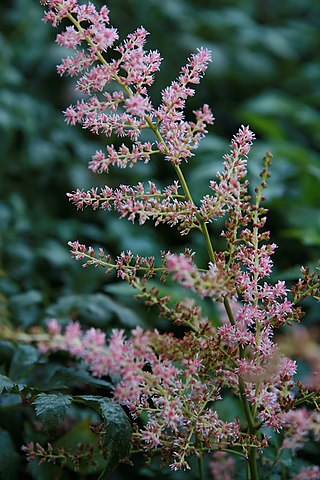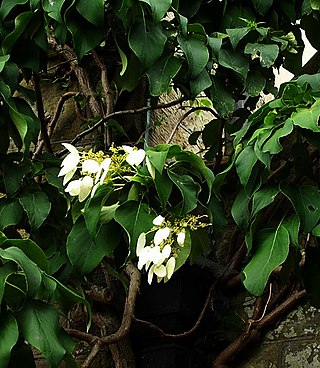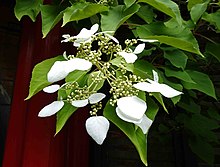
Hydrangea, commonly named the hortensia, is a genus of more than 70 species of flowering plants native to Asia and the Americas. By far the greatest species diversity is in eastern Asia, notably China, Korea, and Japan. Most are shrubs 1–3 m tall, but some are small trees, and others lianas reaching up to 30 m (100 ft) by climbing up trees. They can be either deciduous or evergreen, though the widely cultivated temperate species are all deciduous.

A botanical name is a formal scientific name conforming to the International Code of Nomenclature for algae, fungi, and plants (ICN) and, if it concerns a plant cultigen, the additional cultivar or Group epithets must conform to the International Code of Nomenclature for Cultivated Plants (ICNCP). The code of nomenclature covers "all organisms traditionally treated as algae, fungi, or plants, whether fossil or non-fossil, including blue-green algae (Cyanobacteria), chytrids, oomycetes, slime moulds and photosynthetic protists with their taxonomically related non-photosynthetic groups ."

Clivia miniata, the Natal lily or bush lily, is a species of flowering plant in the genus Clivia of the family Amaryllidaceae, native to woodland habitats in South Africa as well as in Eswatini. Given suitable conditions it grows into large clumps and is surprisingly water wise. It is also reportedly naturalized in Mexico. It is a popular plant for shady areas and is commonly seen growing in older established suburbs in most Australian states. It is also popular in New Zealand, Japan, China and the US, particularly California.

Hydrangea quercifolia, commonly known as oakleaf hydrangea or oak-leaved hydrangea, is a species of flowering plant in the family Hydrangeaceae. It is native to the southeastern United States, in woodland habitats from North Carolina west to Tennessee, and south to Florida and Louisiana. A deciduous shrub with white showy flower heads, it is grown as a garden plant, with numerous cultivars available commercially.

Hydrangea arborescens, commonly known as smooth hydrangea, wild hydrangea, sevenbark, or in some cases, sheep flower, is a species of flowering plant in the family Hydrangeaceae. It is a small- to medium-sized, multi-stemmed, deciduous shrub up to 2 m (7 ft) tall that is native to the eastern United States.

Athyrium niponicum, the Japanese painted fern, is a species of fern native to eastern Asia.

Allium moly, also known as yellow garlic, golden garlic and lily leek, Is a species of flowering plant in the genus Allium, which also includes the flowering and culinary onions and garlic. A bulbous herbaceous perennial from the Mediterranean, it is edible and also used as a medicinal and ornamental plant.

Symphyotrichum novi-belgii, commonly called New York aster, is a species of flowering plant. It is the type species for Symphyotrichum, a genus in the family Asteraceae, whose species were once considered to be part of the genus Aster. Plants in both these genera are popularly known as Michaelmas daisy because they bloom around September 29, St. Michael’s Day.

Hibbertia scandens, sometimes known by the common names snake vine, climbing guinea flower and golden guinea vine, is a species of flowering plant in the family Dilleniaceae and is endemic to eastern Australia. It is climber or scrambler with lance-shaped or egg-shaped leaves with the narrower end towards the base, and yellow flowers with more than thirty stamens arranged around between three and seven glabrous carpels.

Santolina chamaecyparissus, known as cotton lavender or lavender-cotton, is a species of flowering plant in the family Asteraceae, native to the western and central Mediterranean.

Symphyotrichum lateriflorum is a species of flowering plant in the aster family (Asteraceae). Commonly known as calico aster, starved aster, and white woodland aster, it is native to eastern and central North America. It is a perennial and herbaceous plant that may reach heights up to 120 centimeters and widths up to 30 centimeters.

Actinidia kolomikta, the kolomikta, miyamatatabi, variegated-leaf hardy kiwi, is a species of flowering plant in the family Actinidiaceae, native to temperate mixed forests of the Russian Far East, Korea, Japan and China.

Clematis montana, the mountain clematis, also Himalayan clematis or anemone clematis, is a flowering plant in the buttercup family Ranunculaceae. A vigorous deciduous climber, in late spring it is covered with a mass of small blooms for a period of about four weeks. The odorous flowers are white or pink, four-petalled, with prominent yellow anthers. It is native to mountain areas of Asia from Afghanistan to Taiwan.

Symphyotrichum pilosum is a perennial, herbaceous, flowering plant in the Asteraceae family native to central and eastern North America. It is commonly called hairy white oldfield aster, frost aster, white heath aster, heath aster, hairy aster, common old field aster, old field aster, or steelweed. It may reach 20 to 120 centimeters tall, and its flowers have white ray florets and yellow disk florets.

Linnaea chinensis, synonyms Abelia chinensis and Abelia rupestris, commonly known as Chinese Abelia, is a semi-evergreen, densely branched shrub with dark green foliage. It is a species of flowering plant in the honeysuckle family Caprifoliaceae.

Syngonium podophyllum is a species of aroid that is a popular houseplant. Common names include: arrowhead plant, arrowhead vine, arrowhead philodendron, goosefoot, nephthytis, African evergreen, and American evergreen. The species is native to a wide region of Latin America from Mexico through Bolivia, and naturalized in the West Indies, Florida, Texas, Hawaii, and other places.

Astilbe simplicifolia, the entire-leaved astilbe, is a species of flowering plant in the genus Astilbe, native to Japan and North Korea. It is a perennial herb that grows up to 1–1.5 ft (0.30–0.46 m) tall. The Latin specific epithet simplicifolia is in reference to its leaves which are simple. It and its hybrid cultivars 'Atrorosea', 'Bronce Elegans' and 'Sprite' have gained the Royal Horticultural Society's Award of Garden Merit.

Eriocapitella japonica is a species of flowering plant in the buttercup family Ranunculaceae. The specific epithet japonica means "from Japan", which is a misnomer since the species is introduced in Japan. It is native to China, Taiwan, and Vietnam.

Bergenia purpurascens, the purple bergenia, is a species of flowering plant in the family Saxifragaceae. It is a perennial herb and is native to Nepal, the eastern Himalayas, Assam, Tibet, south-central China, and Myanmar. The species, its putative variety Bergenia purpurascens var. delavayi, and its cultivar 'Irish Crimson' have all gained the Royal Horticultural Society's Award of Garden Merit. A useful feature in the garden is the visual interest that its foliage provides by turning a deep beet red during the winter. The Latin specific epithet purpurascens is in reference to the foliage that is purple in color.

Hydrangea glaucescens, the Chinese hydrangea vine, is a species of flowering plant in the family Hydrangeaceae, native to southern China, Myanmar, and Vietnam. As its synonym Schizophragma integrifolium it has gained the Royal Horticultural Society's Award of Garden Merit.





















